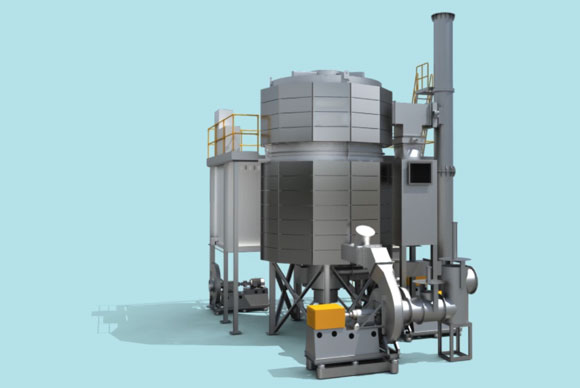What are the best practices for RTO with heat recovery in the food processing industry?
Regenerative Thermal Oxidizers (RTO) are a popular air pollution control technology that can significantly reduce air emissions from industrial processes. In the food processing industry, RTOs can be used to destroy volatile organic compounds (VOCs) and odors that are released during various manufacturing processes. However, RTO systems can be energy-intensive, and the costs associated with operating them can be high. To address these challenges, many food processing facilities have begun implementing RTO systems with heat recovery capabilities. In this article, we will explore the best practices for RTO with heat recovery in the food processing industry.
1. Understanding the Basics of RTO with Heat Recovery
Before implementing RTO with heat recovery, it is essential to understand the basics of how the system works. An RTO with heat recovery utilizes a ceramic media bed to absorb and store heat generated by the oxidation process. This stored heat is then used to preheat incoming process air, reducing the amount of fuel required to sustain the oxidation reaction. The heat recovery process can significantly reduce the operating costs of an RTO system by reducing the amount of natural gas or other fuel needed to operate the system.
2. Choosing the Right Type of RTO with Heat Recovery
When selecting an RTO system with heat recovery for a food processing facility, it is crucial to consider the specific requirements of the manufacturing process. The type of RTO system chosen should be appropriate for the volume and type of emissions generated by the process. Additionally, the RTO system should be designed to handle the specific temperature and humidity conditions of the process air.
3. Proper Maintenance and Inspection of the RTO System
To ensure that an RTO system with heat recovery operates efficiently and effectively, it is vital to perform regular maintenance and inspections. Maintenance activities may include cleaning the ceramic media bed, inspecting the combustion chamber and heat exchanger, and replacing damaged or worn components. Regular inspections can help identify potential issues before they become significant problems, helping to minimize downtime and repair costs.
4. Implementing a Comprehensive Monitoring and Control System
A comprehensive monitoring and control system is critical for ensuring that an RTO system with heat recovery operates efficiently and at peak performance. This system should include sensors and controls that monitor emissions, temperature, pressure, and other critical operating parameters. The monitoring and control system can be integrated with the facility’s existing process control system, allowing for real-time monitoring and adjustment of the RTO system’s operations.
5. Utilizing Modern Technologies and Innovations
The food processing industry is constantly evolving, and new technologies and innovations can improve the efficiency and effectiveness of RTO systems with heat recovery. For example, modern RTO systems may include features such as regenerative burners, which can further reduce energy consumption by recycling heat from the exhaust gases. Additionally, advances in control systems and automation can help optimize the operation of the RTO system, further reducing energy consumption and improving performance.
6. Ensuring Compliance with Regulatory Requirements
Finally, it is essential to ensure that an RTO system with heat recovery complies with all relevant regulatory requirements. Compliance may include obtaining air permits, conducting regular emissions testing, and adhering to specific reporting requirements. Failure to comply with regulatory requirements can result in significant fines and legal penalties, as well as damage to the facility’s reputation.

7. Conclusion
In summary, RTO systems with heat recovery can help food processing facilities reduce air emissions and operating costs. To ensure that these systems operate efficiently and effectively, it is essential to understand the basics of the technology, choose the right system for the manufacturing process, perform regular maintenance and inspections, implement a comprehensive monitoring and control system, utilize modern technologies and innovations, and ensure compliance with regulatory requirements.
Chúng tôi là một doanh nghiệp công nghệ cao chuyên về xử lý toàn diện khí thải hợp chất hữu cơ dễ bay hơi (VOC) và công nghệ giảm carbon và tiết kiệm năng lượng cho sản xuất thiết bị cao cấp. Đội ngũ kỹ thuật cốt lõi của chúng tôi đến từ Viện nghiên cứu động cơ tên lửa lỏng hàng không vũ trụ (Viện hàng không vũ trụ thứ sáu); có hơn 60 kỹ thuật viên R&D, bao gồm 3 kỹ sư cao cấp ở cấp độ nghiên cứu viên và 16 kỹ sư cao cấp. Nó có bốn công nghệ cốt lõi: năng lượng nhiệt, đốt cháy, niêm phong và điều khiển tự động; nó có khả năng mô phỏng trường nhiệt độ và mô hình hóa và tính toán mô phỏng trường luồng không khí; nó có khả năng kiểm tra hiệu suất của vật liệu lưu trữ nhiệt gốm, lựa chọn vật liệu hấp phụ sàng phân tử và thử nghiệm các đặc tính đốt cháy và oxy hóa ở nhiệt độ cao của chất hữu cơ VOC. Công ty đã xây dựng một trung tâm nghiên cứu và phát triển công nghệ RTO và một trung tâm công nghệ kỹ thuật giảm carbon khí thải tại thành phố cổ Tây An và một cơ sở sản xuất 30.000m122 tại Dương Lăng. Khối lượng sản xuất và bán thiết bị RTO vượt xa trên thế giới.
¹«Ë¾¼òÒª½éÉÜ
ÎÒÃÇÊÇÒ»¼Ò¸ß¿Æ¼¼ÆóÒµ£¬×¨×¢ÓÚ»Ó·¢ÐÔÓлúÎï(VOCs)·ÏÆøµÄ×ÛºÏÖÎÀíºÍ̼¼õÅÅÓë½ÚÄܼ¼Êõ¡£ÎÒÃǵĺËÐļ¼ÊõÍŶÓÀ´×Ôº½¿ÕÒºÌå»ð¼ý·¢¶¯»úÑо¿Ëù(º½ÌìÁùÔº)£¬ÓµÓÐ60ÓàÃûÑз¢¼¼ÊõÈËÔ±£¬ÆäÖаüÀ¨3ÃûÑо¿Ô±¼¶¸ß¼¶¹¤³ÌʦºÍ16Ãû¸ß¼¶¹¤³Ìʦ¡£ÎÒÃÇÓµÓÐÈÈÄÜ¡¢È¼ÉÕ¡¢ÃÜ·âºÍ×Ô¶¯¿ØÖÆËÄ´óºËÐļ¼Êõ£»¾ß±¸Ä£Äâζȳ¡ºÍÆøÁ÷³¡·ÂÕ潨ģºÍ¼ÆËãµÄÄÜÁ¦£»¾ß±¸ÌÕ´ÉÐîÈȲÄÁÏÐÔÄܲâÊÔ¡¢·Ö×ÓɸÎü¸½²ÄÁÏÑ¡ÔñÒÔ¼°VOCsÓлúÎï¸ßηÙÉÕºÍÑõ»¯ÌØÐÔµÄʵÑé²âÊÔÄÜÁ¦¡£¹«Ë¾ÔÚÎ÷°²¹Å³Ç½¨Á¢ÁËRTO¼¼ÊõÑз¢ÖÐÐĺͷÏÆø̼¼õÅŹ¤³Ì¼¼ÊõÖÐÐÄ£¬²¢ÔÚÑîÁ轨Á¢ÁËÒ»¸ö30,000m2µÄÉú²ú»ùµØ¡£RTOÉ豸µÄ²úÏúÁ¿ÔÚÈ«Çò´¦ÓÚÁìÏȵØλ¡£
Ñз¢Æ½Ì¨
- ¸ßЧȼÉÕ¿ØÖƼ¼ÊõÊÔÑę́
- ·Ö×ÓɸÎü¸½Ð§ÄÜÊÔÑę́
- ¸ßЧÌÕ´ÉÐîÈȼ¼ÊõÊÔÑę́
- ³¬¸ßÎÂÓàÈÈ»ØÊÕÊÔÑę́
- Æø̬Á÷ÌåÃÜ·â¼¼ÊõÊÔÑę́
¸ÃÊÔÑę́¾ß±¸¸ßЧȼÉÕ¿ØÖƼ¼ÊõµÄÑз¢ºÍ²âÊÔÄÜÁ¦£¬¿É±£Ö¤·ÏÆø´¦ÀíÉ豸µÄ¸ßЧÐÔºÍÎȶ¨ÐÔ¡£
¸ÃÊÔÑę́¿É²âÊÔºÍÆÀ¹À·Ö×ÓɸÎü¸½²ÄÁϵÄÎü¸½Ð§ÄÜ£¬±£Ö¤·ÏÆø´¦ÀíÉ豸µÄÎü¸½Ð§¹û¡£
¸ÃÊÔÑę́¿É²âÊÔºÍÑз¢¸ßЧÌÕ´ÉÐîÈȲÄÁÏ£¬Ìá¸ß·ÏÆø´¦ÀíÉ豸µÄÄÜÁ¿»ØÊÕЧÂÊ¡£
¸ÃÊÔÑę́¿ÉÒÔ¶Ô³¬¸ßÎÂÓàÈÈ»ØÊÕ¼¼Êõ½øÐÐÑо¿ºÍ²âÊÔ£¬ÊµÏÖ·ÏÆø´¦ÀíÉ豸µÄÄÜÁ¿»ØÊÕºÍÔÙÀûÓá£
¸ÃÊÔÑę́¾ß±¸Æø̬Á÷ÌåÃÜ·â¼¼ÊõµÄÑз¢ºÍ²âÊÔÄÜÁ¦£¬È·±£·ÏÆø´¦ÀíÉ豸µÄ°²È«ºÍÎȶ¨¡£

רÀûÓëÈÙÓþ
ÎÒÃÇÔÚºËÐļ¼ÊõÉÏÉ걨ÁË68ÏîרÀû£¬ÆäÖаüÀ¨21Ïî·¢Ã÷רÀû£¬»ù±¾¸²¸ÇÁ˹ؼü²¿¼þ¡£ÒÑ»ñÊÚȨµÄרÀû°üÀ¨4Ïî·¢Ã÷רÀû¡¢41ÏîʵÓÃÐÂÐÍרÀû¡¢6ÏîÍâ¹ÛרÀûºÍ7ÏîÈí¼þÖø×÷Ȩ¡£

Éú²úÄÜÁ¦
- ¸Ö°å¡¢ÐͲÄ×Ô¶¯Å×ÍèÅçÆáÉú²úÏß
- ÊÖ¶¯Å×ÍèÉú²úÏß
- ³ý³¾»·±£É豸
- ×Ô¶¯ÅçÆá·¿
- ºæ¸É·¿
¸ÃÉú²úÏ߾߱¸¸Ö°åºÍÐͲĵÄ×Ô¶¯Å×ÍèÅçÆáÄÜÁ¦£¬±£Ö¤²úÆ·±íÃæµÄÖÊÁ¿ºÍÍ¿²ãµÄÕ³¸½Á¦¡£
ÊÖ¶¯Å×ÍèÉú²úÏß¿ÉÂú×ãÌØÊâ²úÆ·µÄÅ×ÍèÐèÇ󣬱£Ö¤²úÆ·±íÃæµÄÇå½à¶ÈºÍÖÊÁ¿¡£
ÎÒÃÇÉú²úµÄ³ý³¾»·±£É豸¿ÉÒÔÓÐЧ¾»»¯·ÏÆø£¬±£»¤»·¾³ºÍÈËÀཡ¿µ¡£
×Ô¶¯ÅçÆá·¿¾ß±¸×Ô¶¯»¯ÅçÆáÉ豸ºÍ»·¾³¿ØÖÆϵͳ£¬±£Ö¤²úÆ·ÅçÆáÖÊÁ¿ºÍÉú²úЧÂÊ¡£
ÎÒÃǵĺæ¸É·¿¾ß±¸ÏȽøµÄºæ¸ÉÉ豸ºÍÎÂʪ¶È¿ØÖÆϵͳ£¬¿ÉÂú×ã¸÷ÖÖ²úÆ·µÄºæ¸ÉÐèÇó¡£

ÎÒÃǺôÓõ¿Í»§ÓëÎÒÃǺÏ×÷£¬ÒòΪÎÒÃÇÓÐÒÔÏÂÓÅÊÆ£º
- ·á¸»µÄÑз¢¾ÑéºÍ¼¼ÊõʵÁ¦
- ÁìÏȵĺËÐļ¼ÊõºÍרÀû±£»¤
- ÏȽøµÄÉú²úÉ豸ºÍÉú²úÄÜÁ¦
- ¸ßЧµÄ·ÏÆø´¦ÀíºÍ̼¼õÅŽâ¾ö·½°¸
- È«ÃæµÄÊÛºó·þÎñºÍ¼¼ÊõÖ§³Ö
- »ý¼«ÏìÓ¦»·±£Õþ²ß£¬Ìṩ¿É³ÖÐø·¢Õ¹½â¾ö·½°¸

Tác giả: Miya
